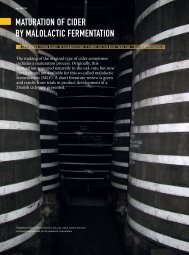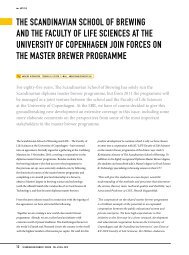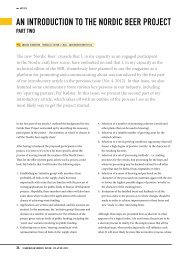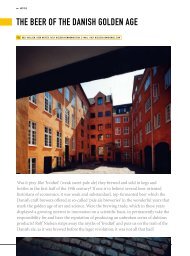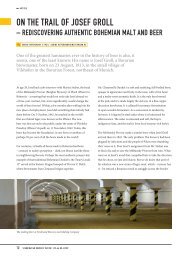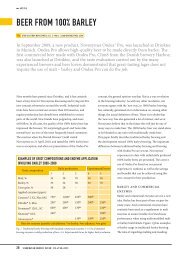BreWiNG OF eNGliSH StYle aleS WitH MalteD ... - Scandbrewrev.dk
BreWiNG OF eNGliSH StYle aleS WitH MalteD ... - Scandbrewrev.dk
BreWiNG OF eNGliSH StYle aleS WitH MalteD ... - Scandbrewrev.dk
You also want an ePaper? Increase the reach of your titles
YUMPU automatically turns print PDFs into web optimized ePapers that Google loves.
B R E W I N G O F E N G L I S H S T Y L E A L E S W I T H M A L T E D C E R E A L S …WheatIn contrast to oats, malted wheat has no husk and canlead to poor mash filtration at high grist levels (> 30%).However, controlled slow speed raking can achieve adequateLauter performance, although wort clarity may be slightlycompromised. Poorer wort clarity may also be influenced bythe higher protein (soluble nitrogen) content.Very high extract recoveries can be obtained from maltedwheat and the high enzyme levels, as indicated by DiastaticPower (DP), may also enhance the extract recovery obtainedfrom the malted barley portion of the grist.RyeLike wheat, malted rye has no husk and the impact on wortrunoff rates can be even more apparent, since the solublenitrogen content is similarly higher than barley. In addition,wort viscosity is also increased, probably from a higher B-glucanand/or pentosan content in rye.The smaller, and somewhat variable, grain size may also dictatethe adjunct level attainable. However, grist proportions at up to30% are achievable without too much impact on brewing cycletimes.Extract recovery from rye is also slightly enhanced over barley.One interesting feature of worts derived from malted rye isthe very red hue of the wort colour. Indeed, restricting colourdevelopment during kilning is an important malting controlparameter.EFFECTS ON BEER FLAVOURThe flavour contributions from these different cereals can besignificant, even at relatively low grist proportions. A review ofthe taste characteristics is presented below.crisp dry citrus and tangy afterpalate is apparent, which has adistinctly refreshing, mouth cleaning effect.These flavour characteristics are most noticeable in pale, lightflavoured products and the effects blend well with warm,golden coloured beers.RyeMalted rye has the most intense flavour effects of all thesecereals. Even at low levels (15%), a distinctiveminty/juicy palate and afterpalate are apparent.These flavour effects combine well with darker malt flavours,such as crystal malts, and the rich ruby red colours attainablewith rye can be successfully augmented with dark malt colours.INFLUENCES ON PROCESSINGCHARACTERISTICSHead RetentionOne key beer analytical parameter influenced by these differentcereals is Head Retention Value (HRV), as indicated in Table 3.The results presented were obtained by the NIBEM methodof analysis and refer to beers of approximately equivalentcomposition in terms of extract levels derived from the othercereals (20%), with other analytical parameters as indicated.It is apparent that malted wheat significantly enhances headforming ability, with malted rye to a lesser extent. This effect isalmost certainly a consequence of the higher protein contentand is in confirmation of previous experience of the beneficialcontribution of wheat to beer head retention.OatsA key flavour attribute provided by malted oats is a pronouncedtoasted, biscuity aroma and palate, combined with a creamyand relatively intense mouthfeel.These flavour effects can be apparent at less than 10%replacement of barley in the grist, depending on the overallstrength of flavour.These flavour attributes blend especially successfully with strawyellow coloured beers.WheatEven at high grist levels (up to 50% ), malted wheat has themost neutral flavour effects of the cereals considered. Overall,there is little influence on aroma, but a creamy, soft palateeffect can be obtained. At slightly higher grist levels (>20%), aTable 3 - Influence on Head Retention – NIBEM MethodHRV: - Malted Barley (100%) : 250 secs- Oat Beer : 245 secs- Wheat Beer : 300 secs- Rye Beer : 265 secsOatsThe slightly reduced HRV seen in Oat beer is almost certainlyrelated to the lower soluble nitrogen content present and isprobably not related to the high lipid content of the oats (themajor portion of which is probably retained in the spent grainsafter lautering). This point is further supported by the observationthat there is no reduction in flavour stability detected in22 SCANDINAVIAN BREWERS’ REVIEW . VOL.65 NO.1 2008



